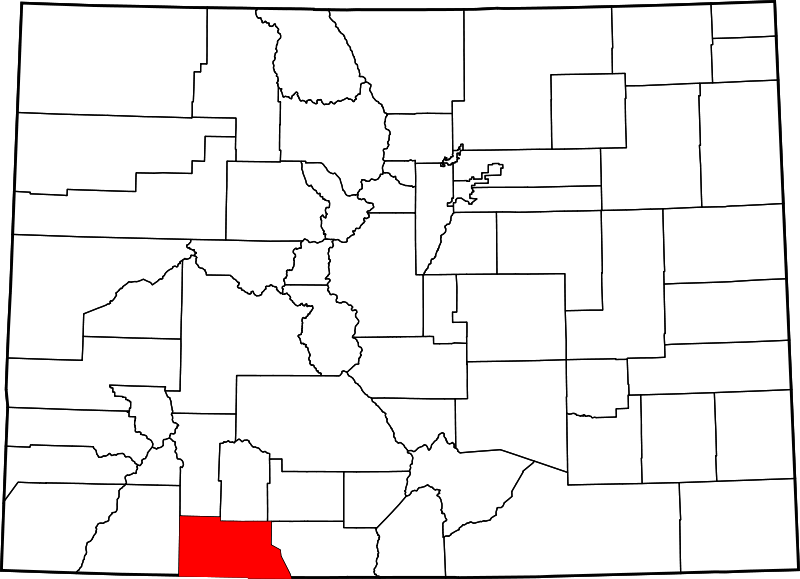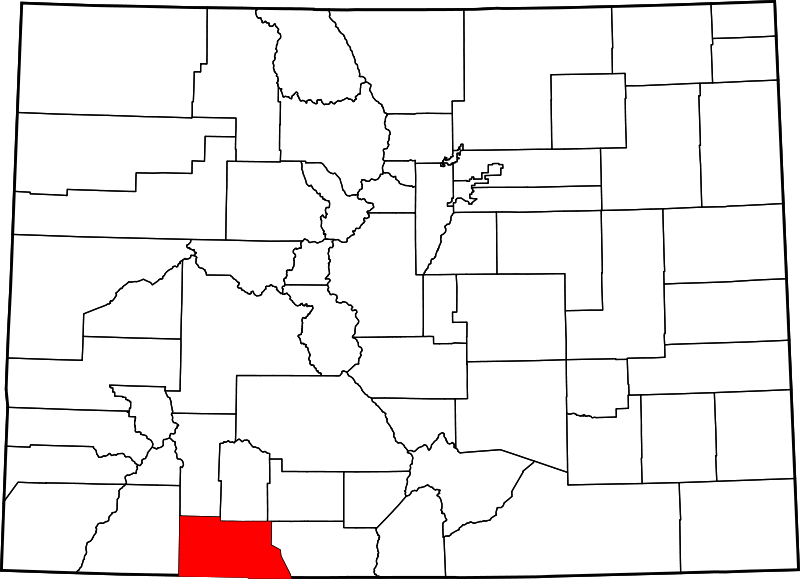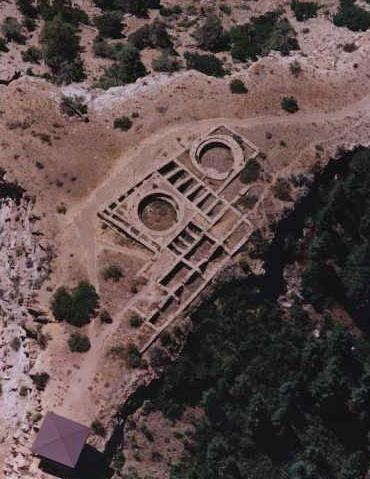Archuleta County
Full Article
Archuleta County covers 1,356 square miles of the San Juan Mountains in southwestern Colorado. The county is bordered to the north by Hinsdale, Mineral, and Rio Grande Counties; to the west by La Plata County; to the east by Conejos County; and to the south by the state of New Mexico. Before Europeans arrived, the area of Archuleta County was occupied first by Ancestral Pueblo peoples and later by Apache, Navajo, and Ute peoples. The county was formally created in 1885. It was named after J. M. Archuleta, the head of a prominent Spanish family in New Mexico, and also in honor of Antonio D. Archuleta, the state senator from Conejos County at the time.
Currently, the county supports a population of 12,084. It encompasses approximately 128,830 acres of the Southern Ute Indian Reservation. It also features 417,521 acres of national forest land, and is home to Chimney Rock National Monument. The San Juan River flows southwest across the county, through Pagosa Springs, the county seat and only incorporated town; it receives the Navajo River about a mile north of the New Mexico border. The Piedra River flows southward in the western part of the county, joining the San Juan at the northern end of Navajo Reservoir near the town of Arboles.
Major roads include US Routes 160 and 84 and state route 151. Route 160 climbs over the San Juans from the San Luis Valley and enters the county from the north; it then turns west at Pagosa Springs, where it meets Route 84. Route 84 continues south into New Mexico, while Route 160 reaches west toward Chimney Rock and La Plata County. Route 151 proceeds southwest from Route 160 near Chimney Rock, following the Piedra River.
Chimney Rock
Around AD 1000, the Chimney Rock area was home to a community of Ancestral Pueblo people. Based on evidence found at the site, archaeologists and anthropologists theorize that Chimney Rock was an outlying settlement of a regional community of Ancestral Pueblo centered in Chaco Canyon, New Mexico. Evidence suggests that Ancestral Pueblo in the resource-rich San Juan basin helped supply a Chaco Canyon community that lacked local supplies of meat, timber, corn, and other resources.
Sometime between 1125 and 1130, the settlements around Chimney Rock were abandoned, followed by the whole Chaco region over the next 200 years. The circumstances and causes of this abandonment have been subjects of debate for at least two decades. While it was initially proposed that a particularly severe drought forced out Chimney Rock’s inhabitants, recent evidence has indicated that the drought was not likely severe enough to completely discourage habitation on its own. Scholars currently debate a combination of causes, most of which stem from environmental exploitation.
Utes, Apaches, and Spaniards
After the Ancestral Pueblo, the area of Archuleta County was primarily the domain of the Nuche, or Ute people. Expert hunters, the Utes subsisted on elk, deer, and other mountain game. They also gathered a wide assortment of roots, including the versatile yucca root, and wild berries.
While the Utes generally maintained peaceful trade relations with the Spanish, the Jicarilla Apache fiercely resisted Spanish encroachment. From the late seventeenth century through the eighteenth century, the Spanish sometimes enlisted the Utes to fight not only the Apache but also the Comanche on the eastern plains and the Pueblo in New Mexico.
The Southern Utes were among the earliest people to frequent the natural hot springs near the current site of Pagosa Springs. Though sometimes translated as “healing waters” or “boiling waters,” “pah gosah” in the Ute language actually means “water with a strong smell,” a description derived from the springs’ high mineral content. In addition to the Utes, the Navajo and Apache also visited the springs.
American Period
An independent Mexico held the Archuleta County area from 1821 until 1848, when the United States took possession after the Mexican-American War. In 1859 a US Army expedition led by Captain John Macomb entered the area, and the following year gold was discovered in the San Juan Mountains near present-day Silverton. Macomb was the first white man to see the Pagosa hot springs, and his accounts prompted a few other curious Americans to visit the springs themselves. Prospectors streamed into the area over the next three decades, leading to the development of mining, logging, and ranching industries.
An 1868 treaty between the Utes and the federal government supposedly protected the Utes’ land in the Archuleta County area but soon after, white ranchers began to drive and graze their cattle on Ute lands. In response to these violations, the Utes conducted raids, which prompted the Army to establish Fort Lewis on the current site of Pagosa Springs in 1878. Access to the hot springs was more or less controlled by the Utes until the establishment of the fort and the founding of Pagosa Springs in the 1870s. In 1881 Thomas Blair built the town’s first bathhouse, using a canal to divert water from the springs.
By the early 1880s most of the remaining Southern Utes were pushed onto the Southern Ute Indian Reservation, a fifteen-mile-wide strip of land in southern Colorado that stretched from the Utah border in the west to the upper San Juan River in the east. In 1880 the army began its abandonment of the Pagosa Springs outpost. The new Fort Lewis was established that same year on the La Plata River, about fourteen miles southwest of Animas City. The military had completely left the Pagosa Springs area by 1882.
It was around this time that Hispano communities began to develop in the southern part of the area, following the advances of the Denver & Rio Grande Railroad. In 1885 the state legislature created Archuleta County out of territory from Conejos County. The town of Pagosa Springs, named after the Ute word for the nearby hot springs, grew around Fort Lewis and was incorporated in 1891.
Changing Economy
By 1900, the prevalence of logging and ranching brought the railroad to Pagosa Springs. When the railroad connected to towns further west, such as Durango, it made the logging and ranching industries the backbone of the regional economy. After a devastating flood in 1911, the state built a modern highway—today’s US Route 160—over the Continental Divide at Wolf Creek Pass in 1916. By 1920 loggers had finally cut all of the accessible timber, and the logging boom petered out. Many residents moved out of the county during the ensuing Great Depression, and the rural county did not see a major economic revival until the 1970s, when developers began purchasing land to capitalize on the area’s scenic beauty.
By 1900 the railroad brought more visitors seeking a soak in the springs, but advancements in medicine over the next two decades made health-seeking trips less popular. In the 1950s, with the roads full of vacationing families, entrepreneurs began building motels that offered access to the springs, and the waters regained their popularity. By the 1990s, full resorts were being developed around the town’s three access points to the waters.
Today
Today in Pagosa Springs, tourism and services are the most important industries, and construction of both permanent and second homes is also regarded as an economic driver. Per capita income remains below the 2014 state average of $32,357 but increased from $25,421 in 2010 to $28,506 in 2014. The tourism industry is buttressed by the Springs Resort & Spa, Healing Waters Resort & Spa, and the Overlook Hot Springs, each of which offer hot springs experiences to visitors.
Local officials have recently begun looking into the area’s geothermal reserves to meet the county’s energy demands. In the fall of 2014 the Pagosa Area Geothermal Water and Power Authority (PAGWAPA)—a group of three Archuleta County commissioners, three Pagosa Springs council members, and one resident—began investigating the possibility of extracting boiling-hot water from the ancient rock below Pagosa Springs for energy and other purposes. With approval from PAGWAPA, the renewable energy company Pagosa Verde conducted exploratory drilling between 2014 and 2016. To help fund the exploratory drilling, Pagosa Verde secured more than $6.5 million in taxpayer funds, including a $3.9 million grant from the federal Department of Energy.
However, after the first few exploratory wells failed to turn up promising geothermal resources, the Department of Energy pulled its funding. A report by Pagosa Verde published in September 2015 concluded only that “a favorable area for potential geothermal resource” lies west of Pagosa Springs. As of January 2016 the future of geothermal development in Archuleta County remains unclear.










